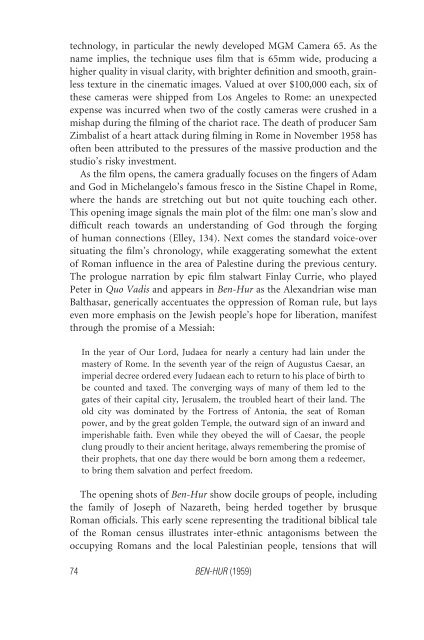Big Screen Rome - Amazon Web Services
Big Screen Rome - Amazon Web Services
Big Screen Rome - Amazon Web Services
Create successful ePaper yourself
Turn your PDF publications into a flip-book with our unique Google optimized e-Paper software.
technology, in particular the newly developed MGM Camera 65. As the<br />
name implies, the technique uses film that is 65mm wide, producing a<br />
higher quality in visual clarity, with brighter definition and smooth, grainless<br />
texture in the cinematic images. Valued at over $100,000 each, six of<br />
these cameras were shipped from Los Angeles to <strong>Rome</strong>: an unexpected<br />
expense was incurred when two of the costly cameras were crushed in a<br />
mishap during the filming of the chariot race. The death of producer Sam<br />
Zimbalist of a heart attack during filming in <strong>Rome</strong> in November 1958 has<br />
often been attributed to the pressures of the massive production and the<br />
studio’s risky investment.<br />
As the film opens, the camera gradually focuses on the fingers of Adam<br />
and God in Michelangelo’s famous fresco in the Sistine Chapel in <strong>Rome</strong>,<br />
where the hands are stretching out but not quite touching each other.<br />
This opening image signals the main plot of the film: one man’s slow and<br />
difficult reach towards an understanding of God through the forging<br />
of human connections (Elley, 134). Next comes the standard voice-over<br />
situating the film’s chronology, while exaggerating somewhat the extent<br />
of Roman influence in the area of Palestine during the previous century.<br />
The prologue narration by epic film stalwart Finlay Currie, who played<br />
Peter in Quo Vadis and appears in Ben-Hur as the Alexandrian wise man<br />
Balthasar, generically accentuates the oppression of Roman rule, but lays<br />
even more emphasis on the Jewish people’s hope for liberation, manifest<br />
through the promise of a Messiah:<br />
In the year of Our Lord, Judaea for nearly a century had lain under the<br />
mastery of <strong>Rome</strong>. In the seventh year of the reign of Augustus Caesar, an<br />
imperial decree ordered every Judaean each to return to his place of birth to<br />
be counted and taxed. The converging ways of many of them led to the<br />
gates of their capital city, Jerusalem, the troubled heart of their land. The<br />
old city was dominated by the Fortress of Antonia, the seat of Roman<br />
power, and by the great golden Temple, the outward sign of an inward and<br />
imperishable faith. Even while they obeyed the will of Caesar, the people<br />
clung proudly to their ancient heritage, always remembering the promise of<br />
their prophets, that one day there would be born among them a redeemer,<br />
to bring them salvation and perfect freedom.<br />
The opening shots of Ben-Hur show docile groups of people, including<br />
the family of Joseph of Nazareth, being herded together by brusque<br />
Roman officials. This early scene representing the traditional biblical tale<br />
of the Roman census illustrates inter-ethnic antagonisms between the<br />
occupying Romans and the local Palestinian people, tensions that will<br />
74 BEN-HUR (1959)



